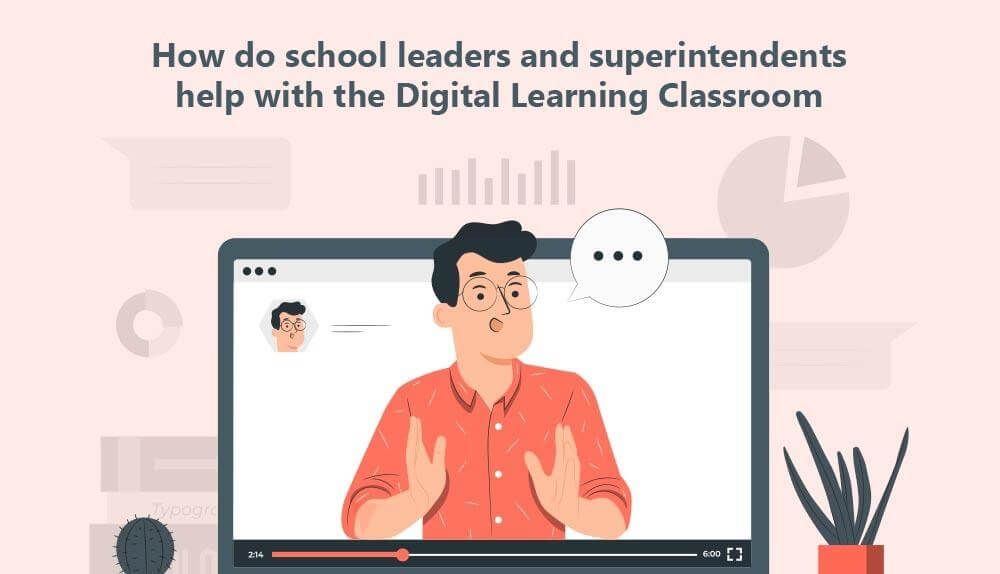Blogs
How do school leaders and superintendents help with the Digital learning classroom?

The outbreak of COVID-19 has led to a newfound interest in digital smart classrooms, which have been around since 1976. For school leaders and superintendents, it's important to stay open-minded and adaptable as a leader. What worked in the past might not be effective now, so it's crucial to be able to discern what still works and what doesn't. Be wise and don't be afraid to try new things. The landscape has changed, and you need to change with it.
With the many advantages they offer, more and more learners and teachers are interested in learning and working in virtual environments. With the advances in technology, virtual classrooms are now able to provide so much more to students, instructors, and educational institutions.
School leaders and superintendents need to set clear expectations for virtual learning. Whether it's focusing on growth, scores, engagement, or social/emotional well-being, make sure all teachers and staff know what the priorities are. This way, everyone can work together to achieve their goals.
The Advantages of Digital Classrooms
Virtual classrooms offer a wealth of benefits for students, teachers, and institutions. These benefits extend far beyond today's concerns about social distancing due to the COVID-19 pandemic. School leaders and superintendents must make teachers and students aware of the many benefits of Digital Smart Classrooms.
Digital classrooms offer a range of benefits for both students and teachers:
- By asynchronous learning options, students can balance work and family obligations.
- Students can keep up with coursework even if they are feeling ill.
- Students get a wider range of viewpoints.
- It encourages collaboration and the development of professional skills.
Digital classrooms can benefit teachers in a wide variety of ways:
- Pre-recording lectures means quality time spent on discussion, student questions, office hours, grading, and more.
- Teachers can maintain their usual class schedule even when family or health issues would interfere in a traditional classroom setting.
- Broadens the audience for classes, and boosts enrolment. Teachers can easily maintain their required teaching loads.
- Universities can expand their enrolment and reputation by offering online learning options.
- Faculty can be hired from anywhere in the world.
- It reduces the need for substitute teachers.
This innovative option for learning can help universities gain a reputation boost as being ahead-of-the-curve and innovative.
Start digital smart classrooms with 9 steps in mind
As a teacher, you have the opportunity to create a virtual classroom that is perfect for you and your students. By following a few simple steps, you can set up an online space that is both productive and enjoyable. With a little planning and preparation, your virtual classroom can be a great success!
Provide Adequate Tech Training
Experienced teachers especially play a vital role in leading and supporting their colleagues, and we must make sure they are equipped with the knowledge and skills needed to thrive in this new digital environment.
Check Equipment
It’s important to make sure your equipment is up to the task. You don’t want to be the cause of a delay or failure in the meeting!
Allow the students to test their equipment.
Do they have the right camera for the job? Do you have all the apps they need? Are their batteries fully charged? Yes, they are important to consider before you kick off your first class.
Adjust Your Syllabus to the Needs of Your Virtual Classrooms.
Rethink your approach to course design and adopt a more active, project-based learning approach. With this approach, you can increase student participation, bolster critical thinking skills, and promote lifelong learning.
Check for Pre-Recorded Videos, Readings, Assignments, and More
Before you start, have you double-checked that all pre-recorded videos are working, readings are up to date, and assignments are completed? Or are you planning to do so at the last minute?
Give Students Access to Whiteboards and Branded Video Players
There are a number of digital smart classroom tools like whiteboards and video players. Depending on the platform, students can write on a whiteboard and the instructor can capture their writing to share with others. Videos, on the other hand, can be used to review course materials, demonstrate key concepts, or simply add some extra fun to an online class.
Use a Grading Metric
Teachers often use assignment assessments like interactive quizzing to monitor and evaluate student progress. Online learners are also encouraged to participate in online collaboration groups, where they work on group projects or other course-related activities.
Explore Analytics to Encourage Your Students
Learning analytics is a great way to get a better understanding of how students interact with classroom materials. In digital smart classrooms, they help you judge the progress of the students.
Build Your Classroom Community
It's important to create a sense of community in your digital classrooms so that students can connect on a personal level. This will enrich the learning experience and make it more enjoyable for everyone involved. Discussion, debate, and group projects will enrich the learning experience, but it’s also important that students connect on a personal level. When choosing a virtual classroom solution, it is essential to pick one that is cutting-edge and designed specifically for educational needs. This will ensure that you can provide the best possible learning experience for your students.




